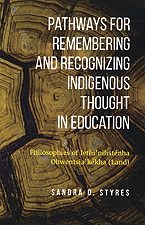
Sandra D. Styres.
University of Toronto Press, 2017; 234 pp;
ISBN: 978-1-48752-163-9.
by Michael Dudley
In 1613, the Hodenosaunee (Iroquois) and Dutch settlers in upstate New York established the Guswhenta or Two Row treaty, named for the two beaded rows on a Wampum belt symbolizing the boats of Indigenous peoples and Europeans, travelling together but not interfering with the other.
For Sandra Styres, the Guswhenta is a powerful metaphor for transforming dominant Western institutions of education: two distinct, sovereign world views with an ethical space between them for learning from each other, but in a context that both de-centers Western epistemologies while re-centering those of Indigenous cultures. With combined Mohawk, English and French heritages, Styres teaches Indigenous education at the Ontario Institute for Studies in Education. She takes her title from — and structures her book around — the Kanien’keha:ka (Mohawk) phrase Iethi’nihsténha Ohwentsia’kékha which means “our Mother the Earth” and regards the Earth (Land) as sentient.
The book is organized according to the four headings of vision, relationships, knowledge and action, with a fifth concluding section on (re)actualizing Iethi’nihsténha Ohwentsia’kékha (Land). Each section is preceded by a circular diagram synthesizing Hodenosaunee and Anishinaabe epistemes, and which locates each particular aspect in terms of a cardinal direction, a sacred medicine (e.g., sage), and an aspect of existence (physical, cognitive, spiritual and emotion).
Styres draws on the Indigenous knowledges of both Turtle Island (North America) — primarily Mohawk and Hodenosaunee — and Aotearoa (New Zealand), having worked in the “Land of the Long White Cloud” on two different occasions. In the spirit of understanding “how Indigenous and dominant Western knowledges can coexist to form new, distinctly sovereign relationships” (p. 21), Styres bases her analysis throughout on readings of Indigenous scholars such as Taiaiake Alfred (Mohawk) and Gregory Cajete (Tewa) as well as Western scholars like Henri Lefebvre and Michel Foucault.
Consistent with her goal of re-centering Indigenous knowledge (especially verb-oriented Indigenous languages), the disciplinary focus of Styres’ book — education — does not appear until section three (knowledge), at almost the 100 page mark. Instead, the first half of Pathways consists of descriptions of Indigenous ways of knowing and being, built around the relationships between the Land (deliberately capitalized, sentient, inhabited and storied), and between ourselves and other beings.
Styres is profoundly (indeed, sometimes painfully) reflexive throughout, explicitly adopting a position of what Rauna Kuok-kanen (Sami) (2007) refers to as critical intimacy: that, as a scholar of both Indigenous and European ancestry but who does not speak her Indigenous language (thus limiting her ability to describe Indigenous ways of knowing), she recognizes her embeddedness — and therefore complicity — in the very Eurocentric institutions of learning she critiques.
At the same time she is deliberately provocative: she challenges and deconstructs comforting notions of decolonizing by arguing that the term still takes as its starting point the perspective of the colonizer; she instead de-centers decolonization in favour of re-centering Indigenous thought. The primacy she places on decentering animates every page of the book: all geographies are given their Indigenous names followed by their colonized names in brackets, and every word featuring a “re” prefix (e.g., remember, recognize, regenerate) places these two letters in brackets, with the effect that that reader is continually prompted to challenge their own (colonized) assumptions regarding meanings and intentions.
One of her positionings, however, may be viewed by some as problematic. She rejects notions of white privilege, preferring instead a consciously deracialized dominant privilege capable of locating excesses of power with any group (p. 94). While recognizing the potential for multiple sources of oppression, it would seem to risk underestimating how the specific ideologies associated with whiteness work(ed) to advance the diverse racisms associated with various expressions of colonialism, as Patrick Wolfe observes in his book Traces of History (2016).
Yet, as Styres makes clear, such problematizing is always a fraught process. She concludes the book by recalling her own journey to comprehending Iethi’nihsténha Ohwentsia’kékha (Land) as a doctoral student designing land-based courses, and how these practices and protocols evolved — or as she would have it, morphed like Coyote the trickster — a journey filled with mistakes, struggle and further transformation. That spirit also imbues her book, which is enriched by her own struggles to translate very old and transformative wisdom for the Western academy, and which must — as Kuokkanen would argue — be viewed as a gift.
_________________________________________
Michael Dudley is the community outreach librarian at the University of Winnipeg.